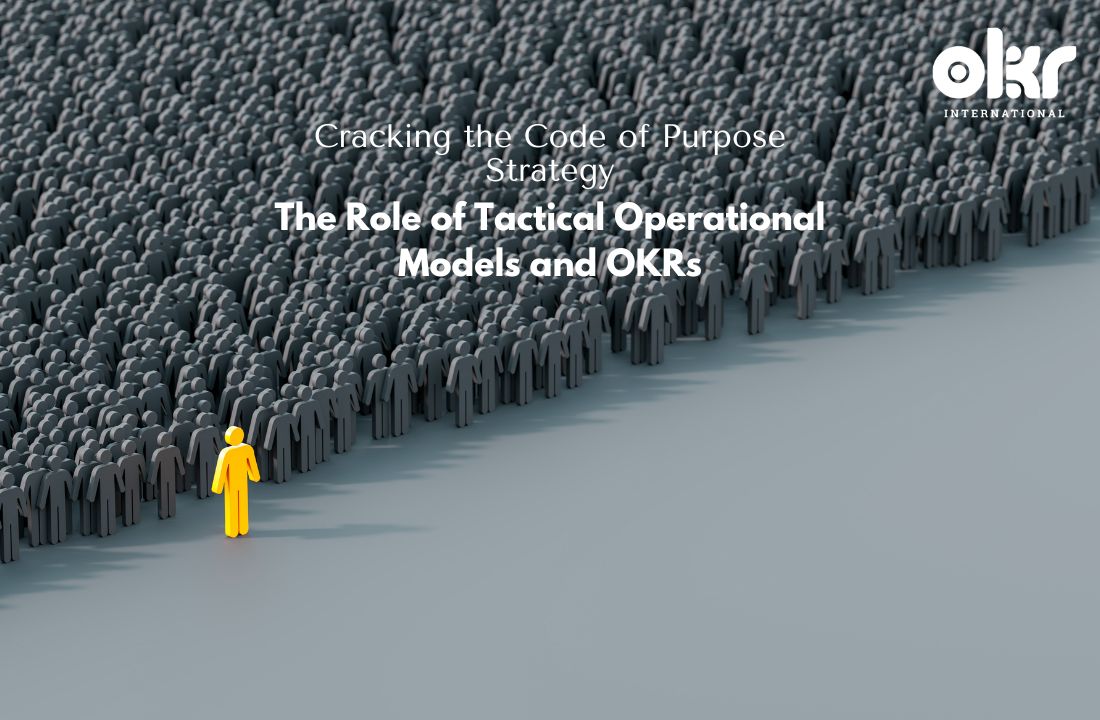Cracking the Code of Purpose Strategy: The Role of Tactical Operational Models and OKRs
The PS-TO (Purpose, Strategy, Tactical, and Operational) model is a framework for aligning organizational goals and objectives at different levels of hierarchy.
This is an upgrade from one of the simplest business frameworks, the Strategy Tactical and Operational (STO) model, and emphasizes the importance of linking Purpose with high-level Strategic objectives with the Tactical and Operational objectives required to achieve them.
And in all of this, there’s need for continuous alignment between them to keep the goals relevant and progressive.
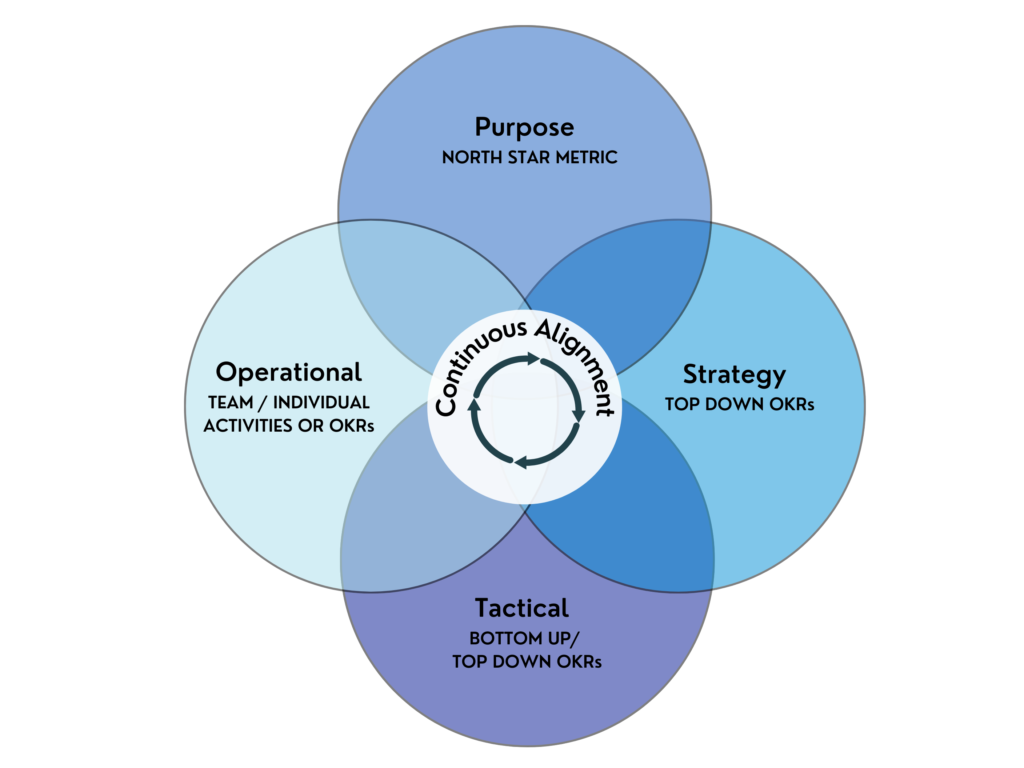
To explain how OKRs (Objectives and Key Results) and the PS-TO model can be used we will use a fictitious e-commerce company named “HealthSprout”. They are a successful US based online company that sells health and wellness products. They have been bootstrapped all through the past 5 years and have grown in a profitably and steadily.

We will look at their:
- Purpose and their North Star.
- Then their Strategy,
And then their Tactical and Operational OKR examples.
Step 1: Purpose Level
Adding Purpose before Strategy gives a company better clarity to focus their strategy on a deliberate end-goal. Purpose is an overarching statement that defines the why of the business. It is the fundamental reason why the organization was established and what it seeks to accomplish. It provides a sense of direction and meaning to the people who work within the organization, helps them to align their efforts towards a common goal, and provides a framework for decision-making.
Here’s HealthSprout’s purpose:

We then ask ourselves ‘how do we know we are getting close to this purpose?’ This is where a North Star Metric (NSM) can be useful. It represents the ultimate goal of an organization. It is a clear and measurable metric that aligns with the organization’s purpose and is critical to its success. By focusing on the North Star Metric, an organization can ensure that its efforts are directed towards achieving its ultimate goal, rather than being distracted by short-term gains or individual initiatives. It provides a clear message about what the organization is trying to achieve and why it matters. This can help to build trust and credibility with customers, investors, and the public, which is essential for the long-term success of the organization.
Here’s HealthSprout’s NSM:

Step 2: The Deliberate Strategy
The strategy is created by identifying the key initiatives, actions, and resources necessary to achieve the North Star Metric while staying true to the organization’s purpose. This involves analyzing the organization’s strengths, weaknesses, opportunities, and threats, as well as understanding the needs and preferences of its stakeholders. Based on this analysis, the organization can identify the critical success factors and develop a roadmap that outlines the steps necessary to achieve the North Star Metric. These are a set of key strategic decisions derived from the ambition of the organization. It also provides guidance for planning key investments, guardrails, and activities to achieve those goals. A simplified version of the plan can be used by management as well as employees.
When developing the strategy, it’s imperative to make decisions on budgeted investments initiatives that are above and beyond the regular running of the business.
Here are the strategic decisions with the levers of growth for Healthsprout:
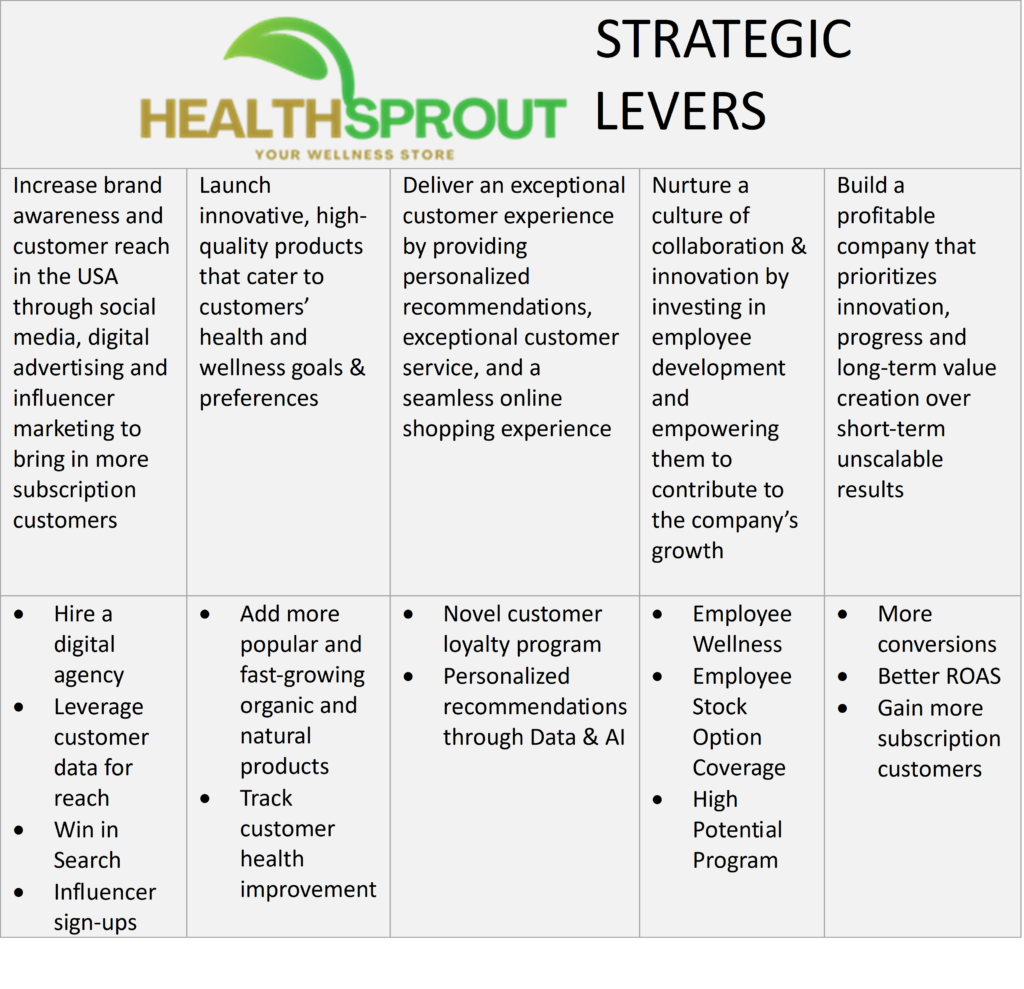
Step 3: Strategic Level OKRs
In crafting these first level OKRs, the leaders of the organization will make the following the decisions:
- What from the purpose strategy will become OKR goals?
- What are the critical success factors necessary to achieve the north star?
- How many OKRs will we have? What will their time frames be?
- What will be the cadence of setting and reviewing these OKRs?
- How many moonshots and roofshots?
- Will they be cascaded, or will they have bottom up contributing OKRs?
- Who will be the owners of the Os and KRs?
- What will continue as Business as Usual?
Here is an example of a Moonshot OKR which is a multi-year Objective that has annualized KRs. In this case, each KR has an owner.
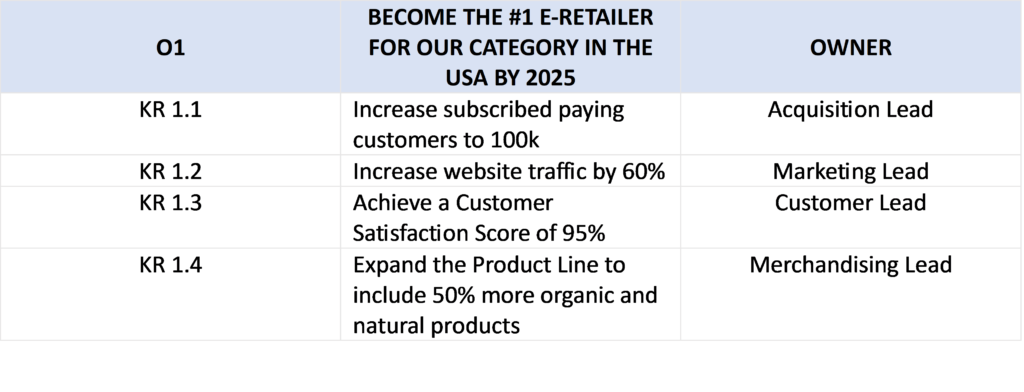
Here is an example of a Committed OKR. By the end of the year, 100% of the KR goal needs to be achieved. In this case too, each KR has an owner.
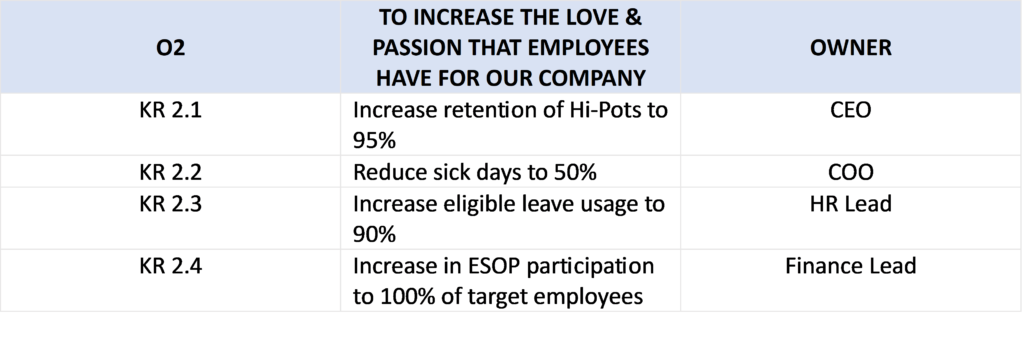
Dos and Don’ts when creating Strategic OKRs
Dos:
- Ensure that strategic level OKRs are aligned with the company’s strategy, north star, and purpose.
- Set ambitious but achievable goals that inspire and motivate the team. Explain the ambition with business commitments on investments for innovation and growth.
- Involve top management in the process to ensure buy-in and alignment.
- Ask the top managers to agree on dependencies which will then help craft their tactical OKRs.
- Ensure you communicate the rationale behind these OKRs to everyone.
- Give them enough lead time to then produce their Top-Down & Bottom-up Tactical and Operational OKRs.
- Most of the KRs may be Lagging metrics.
Don’ts:
- Do not set too many strategic level OKRs. Focus on the most critical goals to avoid diluting efforts and resources. It’s OK to have just one strategic OKR as well.
- Avoid being non-inspirational with your Objectives.
- Do not set unrealistic or vague objectives that cannot be measured or achieved within the desired timeframe.
- It’s advisable not to have only revenue related OKRs. Add OKRs around transformation, innovation, differentiation, customer impact, value creation and people.
- Be open to adjusting OKRs based on changing circumstances or new information. Being too rigid can limit adaptability and agility.
Step 4: Tactical Level
These are short-term goals and provide insight into the proposed innovations, differentiations, and key projects. Tactical OKR goals are set by a function, department, business unit or a specially formed cross functional team. There are four methods to write Tactical Level OKRs.
Top down:
- OKRs are cascaded to specific departments, functions, or business units.
- These tactical level OKRs will usually have the same strategic objective and or the same strategic Key Result.
- Additional KRs are added that are specific to that Objective and withing circle of control of that department/team.
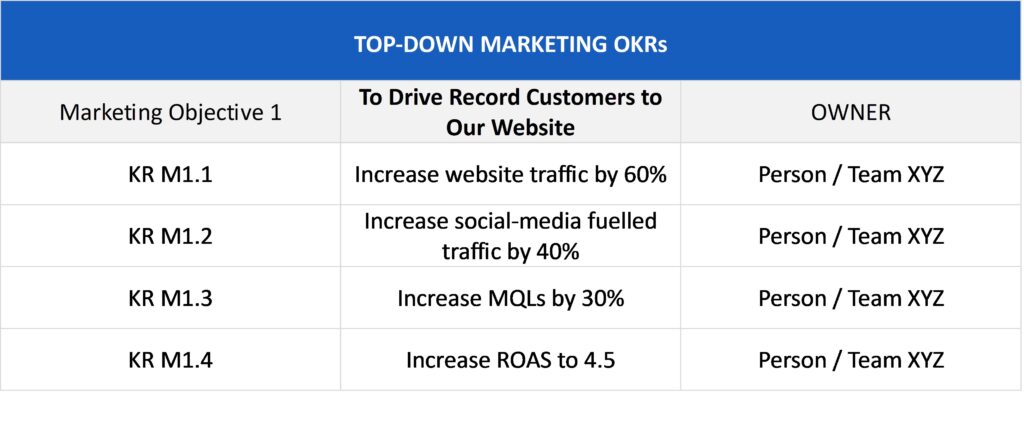
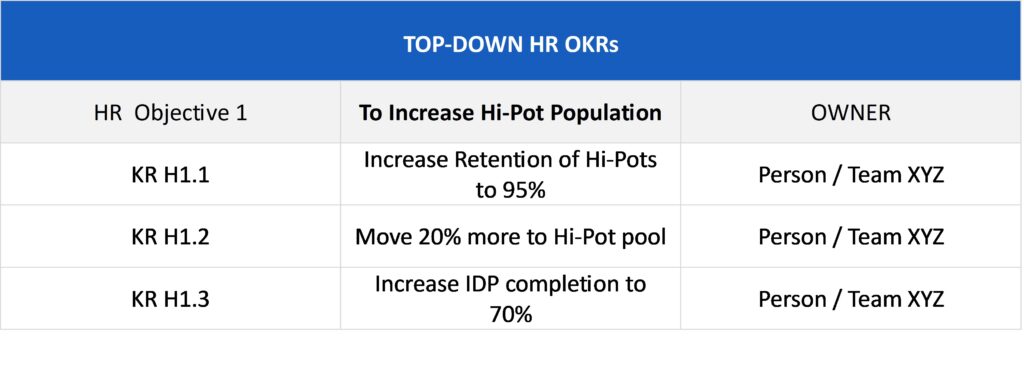
Bottom Up:
- OKRs are created by that department or team that captures their own contributing ambition towards the organization’s strategic OKRs.
- These OKRs are loosely coupled but heavily aligned to the strategy.
- Though there is autonomy to choose the goal, most organizations will have to whet these OKRs to ensure that it is in line with purpose strategy, has no adverse impacts and doesn’t distract the team from its top-down OKRs.
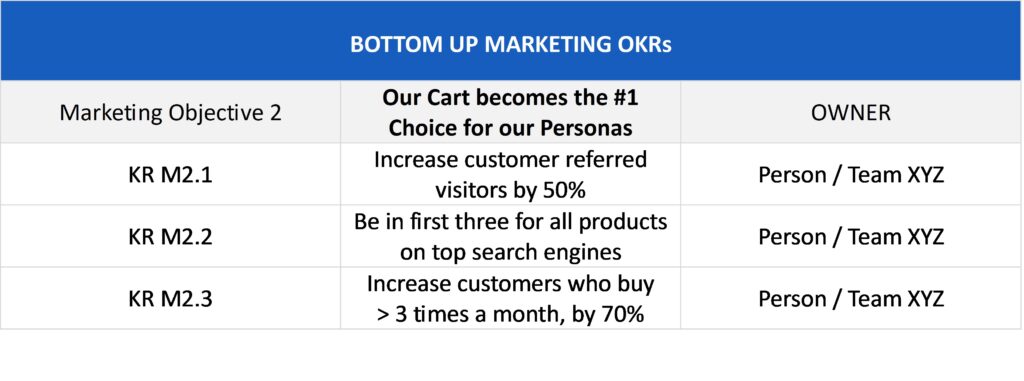
Cross-Functional/Shared OKRs:
- These are OKRs that require two or more departments or teams to work closely to execute them.
- The teams are specially formed to execute this OKR.
- This is an ideal OKR set that promotes collaboration and accountability.
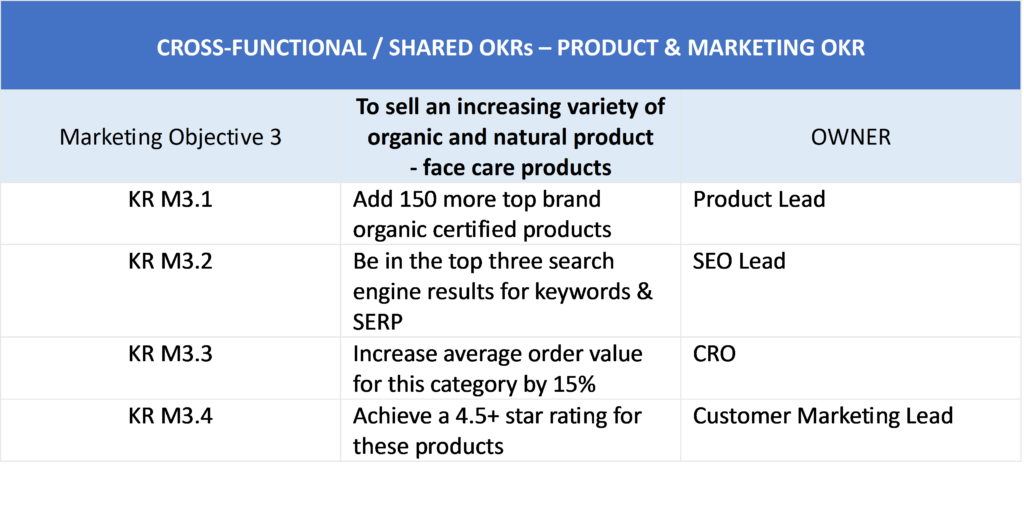
- No OKRs, but only Projects/Initiatives:
- In these OKRs, it doesn’t make sense to create another layer of OKRs since it will take only a bunch of key projects or initiatives to accomplish the higher-level KR.
- This is usually the case of strategic level committed OKRs.
- And where one department or team needs to action this OKR.

Dos and Don’ts when creating Tactical OKRs
Dos:
- Tactical OKRs can be quarterly set and reset with the progressive key results pegged against the Strategic Annual OKRs at the end of every quarter. They can be annual, semi-annual as well for organizations whose environments aren’t very dynamic.
- Ensure that tactical level OKRs are aligned (Top-down and Bottom up) with the strategic objectives.
- Involve mid-level managers in the process to ensure alignment with the overall business strategy.
- Focus on OKRs that can be directly influenced by the team and are critical to achieving strategic goals.
- Have Owners for each KR. The Objective Owner will mostly be the Department/Function leader.
- You may want to list the initiatives under each KR and have owners for them as well. Some KRs may have need additional OKRs that need SMEs or Sub-teams to contribute towards.
- Run an alignment exercise at this level, to see if all the Tactical OKRs are contributing to fulfilling the Strategic OKR. If there is anything that is not sufficiently picked up, then the leaders must investigate whether it’s a lack of understanding, lack of motivation or a lack of resources (time, people, money, technology) that’s preventing teams from setting appropriate OKRs.
- KRs could be a mix of lagging and leading metrics.
- This is where milestone KRs can be found, e.g., Launch a new customer loyalty program before they can become progressive KRs in the next quarter.
Don’ts:
- Do not set too many tactical level OKRs. Focus on the most critical objectives to avoid diluting efforts and resources.
- Do not set objectives that are too narrow or do not contribute to the overall strategic objectives.
- Do not allow for every aspect of the function to be represented in the OKRs. This will result in Business-As-Usual activities showing up.
- Do not discourage the team’s bottom-up ambition. Encourage them if that OKR drives a strategic priority without affecting any other priority.
- Do not force every team or function to set OKRs. Some teams may not need to set OKRs, but only contribute by executing initiatives or supporting other teams in the process.
Step 5: Continuous Alignment
Tactical level goals need more constant alignment. There will be emergent situations such as challenges, constraints or opportunities that could impact the tactical OKRs and their related initiatives.
Scenario 1: Need for continuous alignment due to a challenge:
HealthSprout’s decision to hire a new digital marketing agency backfired. They found out within the first month itself that they could not deliver on the expected performance metrics. This would then impact the SEO, web traffic and social media related OKRs. This changed the decision to have this team set up internally. The team then decides to amend the organization’s expectations for the related OKRs during this transition. And at the same time the HR team finds itself with a new tactical quarterly OKR:
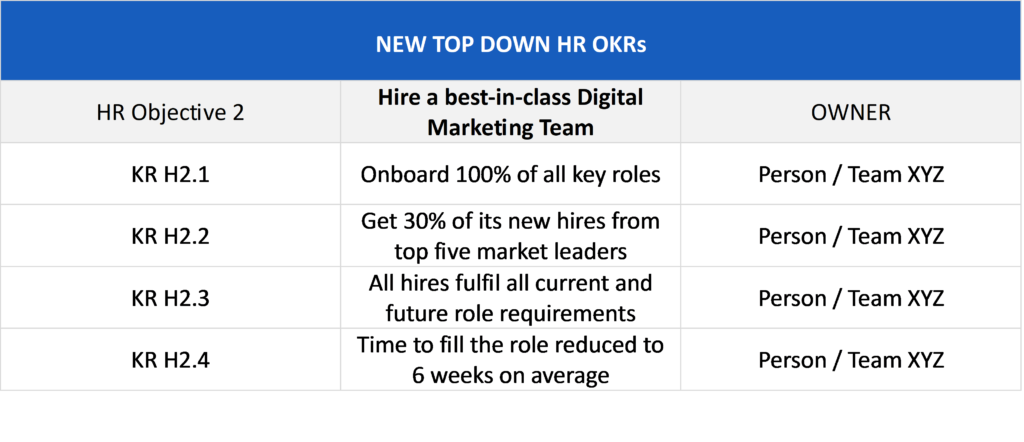
Scenario 2: Need for continuous alignment due to learning.
While progressing working on improving personalized push-recommendations to prospective customers on social media, the team learns that there is a new AI/ML based marketing tool that can help improve the volume accuracy of this activity. They decide hence to invest in a pilot for this new technology. Which then introduces a new KR in the OKR mix for the marketing team.
KR4: Increase accuracy of data fueled personalized recommendations by 30%.
KR5: Increase traffic from push recommendations via social media by 30%
These two KRs impact the Strategic KRs 1 and 2 of the organization as well since the business case is that it will drive more web-traffic and improve conversion of paid customers. The owners of these Strategic KRs can then change their KR targets the following quarter, post the pilot.
Step 6: Operational Level
These are OKRs and initiatives that define day-to-day and frequent operational activities. This is where the rubber meets the roads and teams can closely execute them to provide regular progress to the tactical and strategic OKRs.
There are four ways in which Operational level OKRs can be crafted:
- No OKRs, but only a list of activities: Smaller Intact teams and individuals can produce a list of initiatives, activities, projects, or experiments that they will execute over the quarter to move the needle on the Tactical OKRs.
e.g., The Data & Analytical Team Activity List:
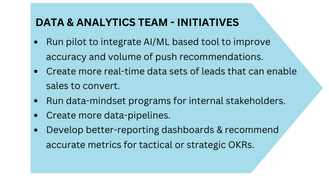
- They create child OKRs that contribute directly to a tactical OKR. These OKRs provide a clear line of sight to the strategic OKRs.
e.g.: The Data & Analytical Team OKRs
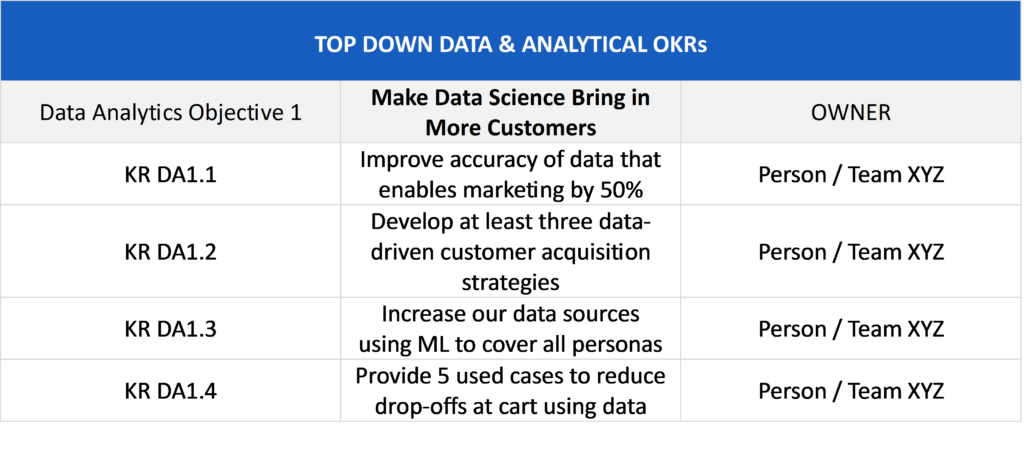
Volition OKRS: Teams & Individuals can create their own OKRs that outline their proposed impact towards the organizations strategic, tactical OKRs. These OKRs can be about improving efficiency or even transforming their practices. The argument here is that efficiency or effectiveness improvement is different from BAU. And the team will have to constantly challenge itself to be better every quarter. These OKRs may not be heavily aligned to this top OKRs. Some organizations may approve of such OKRs if it does not distract the teams or individuals from contributing towards the priority OKRs. Google Chrome is an example of this.
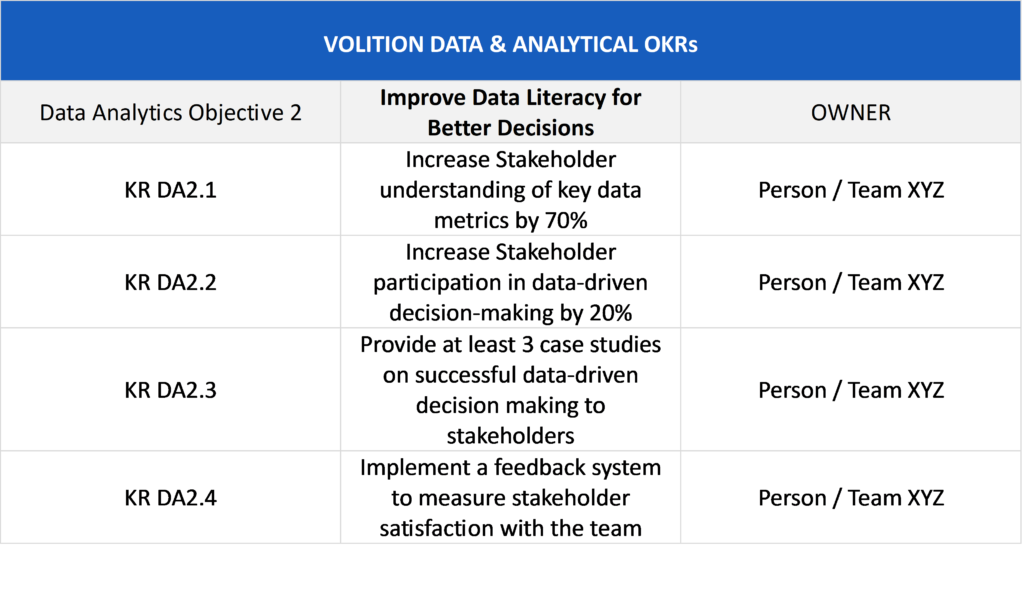
Dos and Don’ts when creating Operational OKRs
Dos:
- Ensure that operational level OKRs are aligned with the tactical and strategic objectives.
- Involve front-line employees in the process to ensure buy-in and alignment.
- Set objectives that are achievable and can be directly influenced by the team.
- The KRs here may be more leading.
- It is completely ok to have output KRs here.
Don’ts:
- Do not set objectives that are too broad or not specific enough. KRs are clearly defined and measurable.
- Do not set unrealistic goals that are beyond the team’s control or resources.
- Don’t force teams or individuals to write OKRs if they have no direct contribution to the strategic OKRs. They are best left to work with the BAU KPI tracking or activity methodology.
Conclusion
In conclusion, by following these steps and the do’s and don’ts when setting and tracking OKRs at each level of the PS-TO model, organizations can ensure that their goals are connected from the highest levels of purpose strategy down to day-to-day operations. This approach can help them achieve their long-term vision while ensuring that each level of the organization is working towards the same objective.

